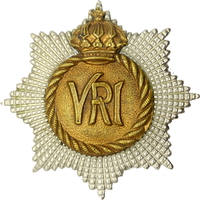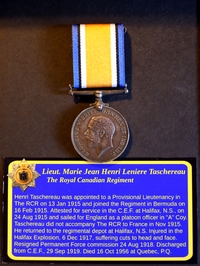
Lieut. Marie Jean Henrie Linière Taschereau
The Royal Canadian Regiment
By: Capt (ret'd) Michael M. O'Leary, CD, The RCR
Marie Jean Henrie Linière Taschereau was born in St. Joseph's, Beauce, Quebec, on 12 Jun 1894. His family appears in the 1901 Canadian Census for the St. Louis Quartier of Quebec city. Parents Thomas Linière (50) and Zoé (née Alleyn, 45) are shown with six children: daughter Stella (22), and sons Alyne (21), Ernest (19), Linière (17), de Gaspe (13), and Henrie (6). The 1901 census shows that the family is sufficiently well-off to have two domestic servants living in the household. Henrie Taschereau's father died shortly after the taking of the 1901 census. In 1911, all of his older siblings have moved out and the census of 1911 shows mother, Zoe, with Henrie (17), as boarders in a residence in the St. Louis ward.
Age the age of 20, Taschereau was appointed to a Provisional Lieutenancy in the Permanent Force with The Royal Canadian Regiment on 13 Jan 1915. The regimental history (Fetherstonhaugh, 1936) notes that this was the first appointment of this kind that had been made for ten years.
On 11 Sep 1914, The Royal Canadian Regiment had sailed for Bermuda where they would serve for a year on garrison duty. The Regiment relieved the 2nd Battalion, Lincolnshire Regiment, which sailed immediately for England. Taschereau joined The RCR in Bermuda on 16 Feb 1915.
In Bermuda, The RCR continued to train its soldiers for their eventual entry into the theatre of war. On 2 Jul 1915, Lieut Taschereau, with Captains F.G. Macculloch and R.E. Balders, accompanied a draft of troops to the Warwick Parish of the island for musketry and field training.
On 12 Aug 1915, The RCR was relieved in turn by the arrival of the 38th Overseas Battalion from Canada. The RCR returned to Halifax for a stay of only a week during which the Regiment was re-attested for overseas service. Although The RCR had just spent a year in Bermuda, there were concerns regarding the applicability of Permanent Force enlistments for wartime deployments. Enlistment in the C.E.F., was for the "Duration of War." Accordingly, The RCR was re-attested, signing C.E.F. attestation papers in August 1915 before sailing for Europe.
Taschereau attested for service in the Canadian Expeditionary Force (C.E.F.) with The Royal Canadian Regiment at Halifax, N.S., on 24 Aug 1915. He identified his mother, Mrs. Liniere Taschereau, 65 ½ St. Cyrille St., Quebec, as his next of kin.
On 26 Aug 1915, The RCR sailed from Halifax aboard the S.S. Caledonian, the same ship that had brought them home from Bermuda. Disembarked at Plymouth, England, on 6 Sep 1915, the Regiment went to Shorncliffe for training. When The RCR sailed for England, Taschereau held the appointment of platoon commander in "A" Company. The Officer Commanding the company was Capt C.R.E. Willets and Capt R.E. Balders was second-in-command. The other three platoon commanders were lieutenants V. Hodson, A.H.C. Campbell, and C.L. Wood.
As a Lieutenant in the Permanent Force, Taschereau was paid an annual rate of pay of $840, which gave him a monthly base rate of pay of $70. This was augmented by Field Allowance at 60 cents per day, a Permanent Force allowance of $17.33 per month, and a Messing Allowance of $1.00 per day. Although the total each month would vary based on the number of days in the month, he received, as an example, Total Pay and Allowances of $146.93 for October, 1915.
Although a specific reason is not recorded in his service record, Taschereau did not accompany The RCR to France in November 1915. He returned to the regimental depot at Halifax, N.S., and was struck off the strength of the C.E.F. Canadian Training Division (C.T.D.) in England on sailing for Canada on 5 Nov 1915.
Taschereau was in Halifax on the day of the Halifax Explosion, 6 Dec 1917. It is noted in his service record that he received cuts to the head and face as a result of the explosion. It is very likely that Taschereau was at Wellington Barracks that morning and, like many residents of the city, was looking out a window toward the harbour where the collision of the S.S. Mont Blanc and the S.S. Imo had resulted in a ship-board fire and rising cloud of smoke. Many of the injured in the explosion were the victims of the glass from the windows they were looking through when the Mont Blanc exploded.
Although he was still serving in the CEF, Taschereau appeared in the Canada Gazette as "permitted to resign his commission" as an officer of the Permanent Force effective 24 Aug 1918. A pay record sheet in his service record noted his address at the time of this change of status as 1724-12th Ave. W., Calgary, Alta.
Henrie Taschereau was discharged from the Canadian Expeditionary Force on resigning his commission in the C.E.F. on 29 Sep 1919. His discharge certificate noted his service as: "Bermuda and England with The Royal Canadian Regiment, Base Depot R.C.R., Conducting Duties to England and 1st Depot Battalion, 2nd Quebec Regiment."
For his service in the C.E.F., Taschereau was entitled to receive only the British War Medal. This medal were despatched to him at 65 1/2 Cyrille St., Quebec, on 4 Aug 1921.
Henrie Taschereau died on 16 Oct 1956 at Ste-Foy General Hospital, Quebec, P.Q. His death was not attributable to his wartime service. The next of kin recorded on his Veteran's Death Card held by Library and Archives Canada was his sister, Lady Stella Fiset.

Henrie Taschereau was a scion of an influential Quebec family which was well established in the Province many decades before Confederation. His direct paternal lineage included the following:
- Great-Great-Great-Grandfather – Thomas-Jacques Taschereau (1680-1749 ), was private secretary to the intendant of New France.
- Great-Great-Grandfather – Gabriel-Elzéar Taschereau (1745-1809 ) was a military officer, a judge, and a public servant.
- Great-Grandfather – Thomas-Pierre-Joseph Taschereau (1775-1826) was a Lieutenant-Colonel and Legislative Counsel.
- Grandfather – Thomas-Jacques Taschereau (1811-1885) was a notary.
- Father – Thomas Linière Taschereau (1850-1901) was a lawyer and mayor of Saint-Joseph-de-Beauce from 1891 to 1893.
Taschereau's sister, Marie-Zoe-Stella Liniere Taschereau married Eugène Fiset in 1902. Major-General Sir Marie-Joseph-Eugène Fiset KCMG DSO ED (1874-1951) was a physician, military officer, Deputy Minister of Militia and Defence, the 3rd Canadian Surgeon General (1914-1923), Member of Parliament (1924-1939), and the 18th Lieutenant Governor of Quebec (1939-1950). Fiset had served in South Africa as the medical officer of the 2nd (Special Service) Battalion of The RCR (1899-1900).
Two of Taschereau's brothers also served in the C.E.F. during the First World War:
Before the First World War, Emile de Gaspe Taschereau was a Permanent Force clerk in the Canadian Ordnance Corps, having enlisted on 1 Oct 1913. He attested for C.E.F. service at Camp Valcartier on 25 Sep 1914 with the 1st Canadian Division Subordinate Staff (regiment number 1841) and was employed in various units as a clerk after going overseas to England. Rising in rank to Staff Sergeant by 8 Feb 1915, Emile Taschereau was reduced to the ranks (i.e., to Private) on 8 Dec 1915 after being charged and found guilty by Court Martial of drunkenness and absence without leave. Promoted again to Acting Sergeant in March 1916, he relinquished this rank in Feb 1917 in preparation for transfer overseas to a unit in France. After four months in Reserve and Depot units, he joined the 18th Canadian Infantry Battalion in the field on 13 Jun 1917. He was killed in action on 20 Jul 1917 while serving with the 18th Battalion.
Liniere Taschereau had seven years, 99 days, prior service in the Permanent Force with the Canadian Ordnance Corps (C.O.C.) when he attested for C.E.F. service on 15 Nov 1918 at Calgary, Alberta. He was given the service number 2775457. Shortly after enlisting with the CEF, he was transferred to No. 13 Detachment, C.O.C., at Calgary. Liniere Taschereau was discharged from the C.E.F., medically unfit, on 15 May 1919, due to persistent effects of a bout of influenza in October, 1918.
Pro Patria
Visit a randomly selected page in The O'Leary Collection (or reload for another choice):
- The O'Leary Collection; Medals of The Royal Canadian Regiment.
- Researching Canadian Soldiers of the First World War
- Researching The Royal Canadian Regiment
- The RCR in the First World War
- Badges of The RCR
- The Senior Subaltern
- The Minute Book (blog)
- Rogue Papers
- Tactical Primers
- The Regimental Library
- Battle Honours
- Perpetuation of the CEF
- A Miscellany
- Quotes
- The Frontenac Times
- Site Map
QUICK LINKS
The O'Leary Collection—Medals of The Royal Canadian Regiment
Newest additions:
![]()
![]() SB-12725 Private Henry "Hank" Ard
SB-12725 Private Henry "Hank" Ard ![]()
WIA at Hill 187, Died of Wounds in Japan
![]()
![]() 2355331 Lance Corporal Albert Lorking
2355331 Lance Corporal Albert Lorking
Wounded in action, later a War Amps representative.
![]()
![]() 4334 / 477996 Pte Isaac Hamilton Wilcox
4334 / 477996 Pte Isaac Hamilton Wilcox
Permanent Force, South Africa, and C.E.F.
![]()
![]() 477019 Private Harold Ashcroft
477019 Private Harold Ashcroft
Transferred to the Tunnelers.
![]()
![]() 734231 Private Clark D. Thompson
734231 Private Clark D. Thompson ![]()
The older Thompson brother, killed in action.
![]()
![]() 733849 Private Norman Parker Thompson
733849 Private Norman Parker Thompson
The younger Thompson brother; post-war service in the Special Guard.
![]()
![]()
![]() A305 / 400305 Private Andrew Walker
A305 / 400305 Private Andrew Walker ![]()
"Previously reported Wounded, now Killed in Action."
![]()
![]() 823298 Pte Thomas Patrick Steele, M.M.
823298 Pte Thomas Patrick Steele, M.M. ![]()
… for gallant conduct in the field …
![]()
![]() P13066 Sergeant Harold Thompson
P13066 Sergeant Harold Thompson
Instrumental Soloist for over 20 years of Canadian Army service.
![]()
![]() 9609 / 477728 Private Albert Edward Piper
9609 / 477728 Private Albert Edward Piper
"Arrived from England as a STOWAWAY …"


